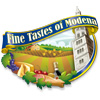Cheese
Parmigiano Reggiano
Parmigiano Reggiano, not being an exclusive product of Modena, holds an important place in our local cuisine and also creates a perfect combination with another famous product of Modena: Traditional Balsamic Vinegar of Modena.
Parmigiano Reggiano is a hard, granular, cured cheese. A piece of Parmigiano Reggiano contains only about 30% water while the remaining 70% is given by nutrients. Precisely for its high nutritional value, Parmigiano Reggiano is essential for a healthy balanced diet offering a high calcium absorption. It also has a high phosphorus content. Imagine; 50 grams (1.76 oz) of Parmigiano Reggiano contain 50% of the daily requirement of phosphorus for adults. But that's not all. During the long curing process, the casein as milk protein undergoes a transformation that makes Parmigiano Reggiano rich in free amino acids which are easily assimilated by the body.
Since Parmigiano Reggiano is lactose-free, it may be safely eaten by people who are lactose intolerant.
How Parmigiano Reggiano Is Made
According to the strict standards setup by the consortium, this cheese can only be labeled Parmigiano Reggiano after being aged for a minimum of 12 months; but its true quality can be enjoyed after it has been cured for at least 24 months. The slow aging is also important for enzymatic transformation that affects the caseins, as well as making the cheese more digestible than other cheeses.
Parmigiano Reggiano is produced in the provinces of Modena, Reggio Emilia, Parma, Bologna and Mantua. In the province of Modena, a particular variety of Parmigiano Reggiano is produced using the milk from the Vacca Bianca Modenese (White Cow of Modena) which makes this an even better quality cheese.
The Vacca Bianca Modenese is an ancient local breed that can be traced back to the mid-1800s. Characterized by its white hide, the Vacca Bianca Modenese is an extremely strong and resilient cow. It was used in farm work as well as for the production of milk and meat. The period of greatest expansion of this breed took place between 1927 and 1940, with a strong presence in the neighboring provinces due to its high quality milk.
The decline of the Vacca Bianca Modenese began after the Second World War as farmers preferred other breeds which were more fragile but produced higher yields of milk. However, even the Vacca Bianca evolved over the years to further develop the production of milk, considering the fact that the Vacca Bianca's milk is particularly suitable for the production of Parmigiano Reggiano. With its optimal 1:1 ratio of fat and protein and the strong presence of the K-casein gene B, necessary for a more rapid and durable coagulation, this milk is more easily workable and results in fewer problems with the delicate production process of Parmigiano Reggiano.
Parmigiano Reggiano is much more expensive than other cheese. The reason for this difference in price depends on several important factors:
* Its high nutritional value.
* The long aging process.
Given the fact that to obtain a quality product, Parmigiano Reggiano must be aged for at least 24 months. This means that the producers and master seasoners will not have an economic return from their work for at least two years, due to the time needed for the product to mature.
* The feeding of cows that produce the milk for Parmigiano Reggiano.
These cows must eat mostly hay from the zones of origin (Parma, Reggio Emilia, Modena, Bologna and Mantua) and can not eat other types of food such as fermented fodder which cost less, but would cause problems with quality during the maturing process of Parmigiano Reggiano.
 Fine Tastes of Modena
Fine Tastes of Modena
follow us on: